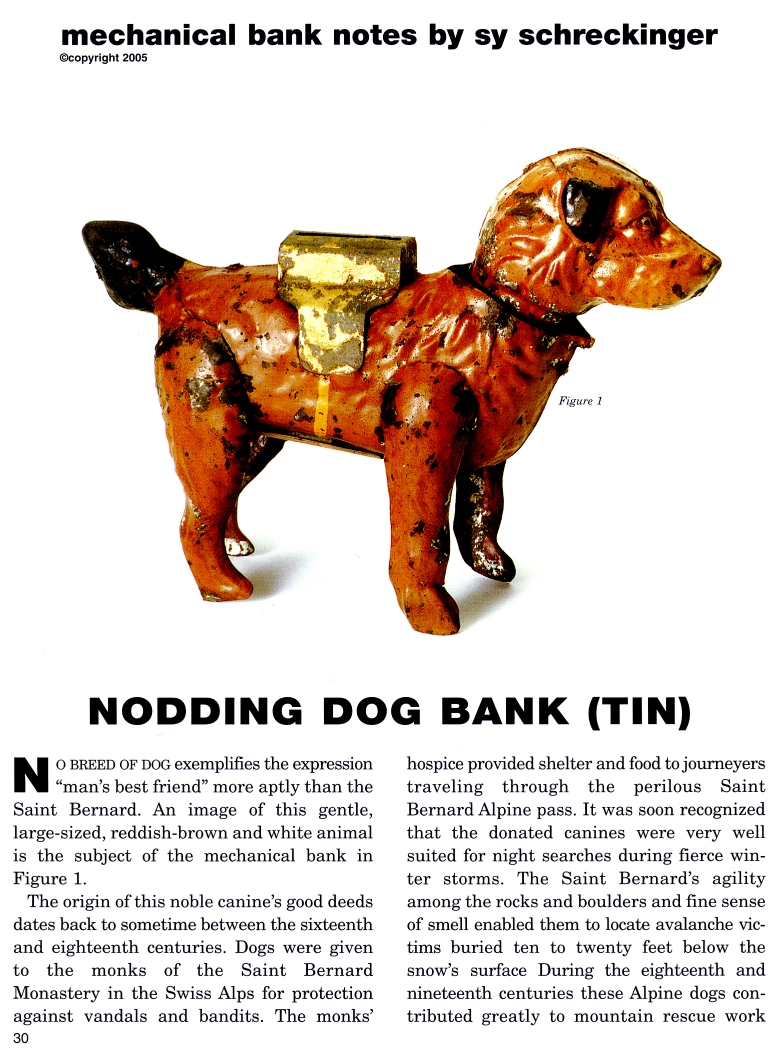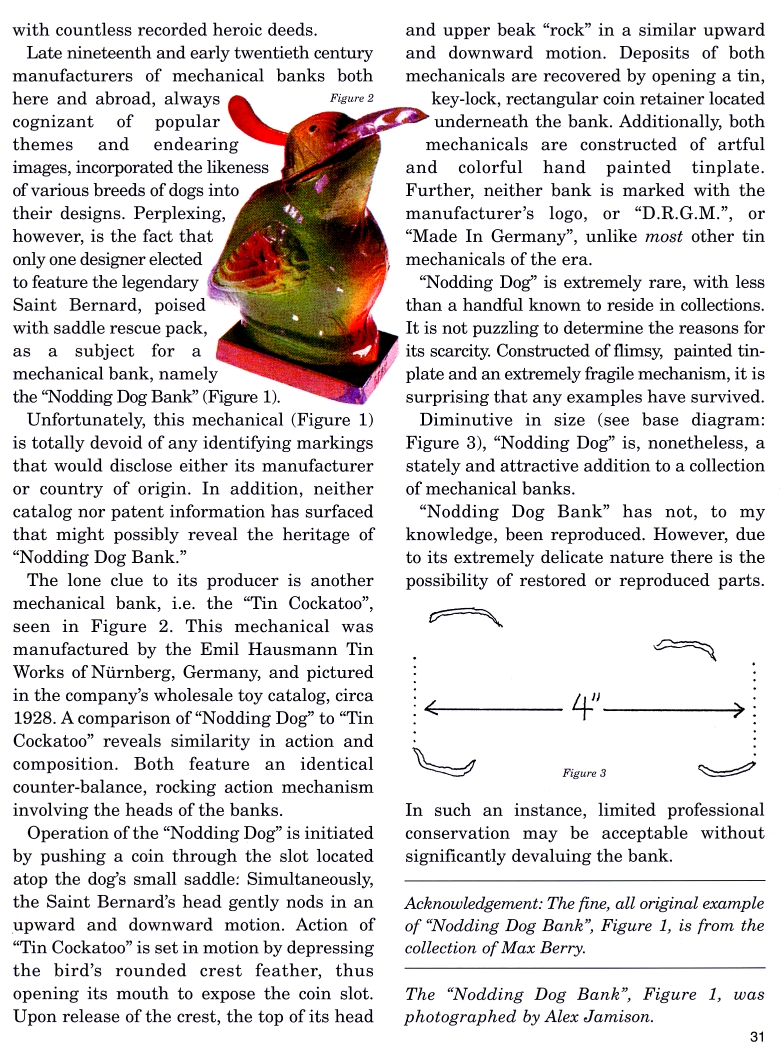|
Nodding Dog Bank (Tin)
by Sy Schreckinger – ANTIQUE TOY WORLD Magazine – October, 2005
No breed of dog exemplifies the expression "man's best
friend" more aptly than the Saint Bernard. An image of this gentle,
large-sized, reddish-brown and white animal is the subject of the
mechanical bank in Figure 1.
The origin of this noble canine's good deeds dates back to sometime
between the sixteenth and eighteenth centuries. Dogs were given to the
monks of the Saint Bernard Monastery in the Swiss Alps for protection
against vandals and bandits. The monks' hospice provided shelter and food
to journeyers traveling through the perilous Saint Bernard Alpine pass. It
was soon recognized that the donated canines were very well suited for
night searches during fierce winter storms. The Saint Bernard's agility
among the rocks and boulders and fine sense of smell enabled them to
locate avalanche victims buried ten to twenty feet below the snow's
surface During the eighteenth and nineteenth centuries these Alpine dogs
contributed greatly to mountain rescue work with countless recorded heroic
deeds.
Late nineteenth and early twentieth century manufacturers of
mechanical banks both here and abroad, always cognizant of popular themes
and endearing' images, incorporated the likeness of various breeds of dogs
into their designs. Perplexing, however, is the fact that only one
designer elected to feature the legendary Saint Bernard, poised with
saddle rescue pack, as a subject for a mechanical bank, namely the
"Nodding Dog Bank"
Unfortunately, this mechanical (Figure 1) is totally devoid of any
identifying markings that would disclose either its manufacturer or
country of origin. In addition, neither catalog nor patent information has
surfaced that might possibly reveal the heritage of "Nodding Dog Bank."
The lone clue to its producer is another mechanical bank, i.e. the
"Tin Cockatoo", seen in Figure 2. This mechanical was manufactured by the
Emil Hausmann Tin Works of Nurnberg, Germany, and pictured in the
company's wholesale toy catalog, circa 1928. A comparison of "Nodding Dog"
to "Tin Cockatoo" reveals similarity in action and composition. Both
feature an identical counter-balance, rocking action mechanism involving
the heads of the banks.
Operation of the "Nodding Dog" is initiated by pushing a coin through
the slot located atop the dog's small saddle: Simultaneously, the Saint
Bernard's head gently nods in an upward and downward motion. Action of
"Tin Cockatoo" is set in motion by depressing the bird's rounded crest
feather, thus opening its mouth to expose the coin slot. Upon release of
the crest, the top of its head and upper beak "rock" in a similar upward
and downward motion. Deposits of both mechanicals are recovered by opening
a tin, key-lock, rectangular coin retainer located underneath the bank.
Additionally, both mechanicals are constructed of artful and colorful hand
painted tinplate. Further, neither bank is marked with the manufacturer's
logo, or "D.R.G.M.", or "Made In Germany", unlike most other tin
mechanicals of the era.
"Nodding Dog" is extremely rare, with less than a handful known to
reside in collections. It is not puzzling to determine the reasons for its
scarcity. Constructed of flimsy, painted tinplate and an extremely fragile
mechanism, it is surprising that any examples have survived.
Diminutive in size (see base diagram: Figure 3), "Nodding Dog" is,
nonetheless, a stately and attractive addition to a collection of
mechanical banks.
"Nodding Dog Bank" has not, to my knowledge, been reproduced.
However, due to its extremely delicate nature there is the possibility of
restored or reproduced parts. In such an instance, limited professional
conservation may be acceptable without significantly devaluing the bank.
Acknowledgement: The fine, all original example of "Nodding Dog
Bank", Figure 1, is from the collection of Max Berry.
The "Nodding Dog Bank", Figure 1, was photographed by Alex Jamison.
Update: (from
February, 2006) New information pertaining to "Nodding Bank" (refer to
Antique Toy World, October 2005) has recently come to my attention.
Firstly, Mr. John Haley, fellow collector and European Money Box
historian, has informed me that this mechanical bank is a depiction of an
actual canine. "Paddington Jack" was a heroic St. Bernard adopted as
mascot of the Paddington Train Station in London, England. A bronze effigy
of "Jack" stands guard at the station entrance.
Secondly, I've been made aware of another "Nodding Dog Bank". This
example exhibits an original paper nametag affixed to its collar. The
following inscription is imprinted upon the tag: "Paddington Jack, Thank
You".
|


